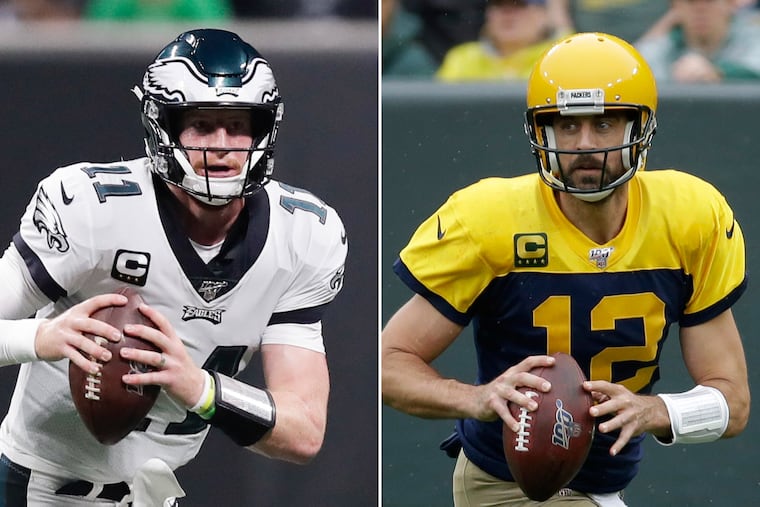The Eagles will have to do for Carson Wentz what the Packers did for Aaron Rodgers | Mike Sielski
Green Bay, the Eagles’ opponent tonight, has built through the draft for most of Rodgers’ tenure. The Birds have to start doing the same.

By the time he was exactly the age that Carson Wentz is now, Aaron Rodgers had spent three years wondering when he’d get his chance to be the Green Bay Packers’ starting quarterback and two years trying — and, in so many eyes, failing — to live up to the standard of his predecessor.
The Packers had gone 13-3 and reached the NFC Championship Game in 2007-08, Brett Favre’s final season with them. Then Favre retired. And un-retired. And was traded to the New York Jets. It was complicated.
Anyway, the team was Rodgers’, finally, and through his first two seasons as a starter, the results were a hodgepodge of hope and frustration and worry. Rodgers compiled marvelous statistics — surpassing 4,000 passing yards each year, throwing 58 touchdowns and just 20 interceptions — and his talents were so obvious that even a football novice could appreciate them. But the Packers went 6-10 in his first season and lost their playoff opener in his second.
Favre, meanwhile, returned to the NFC Championship Game, with the Minnesota Vikings. Aaron was not Brett and could not be Brett because the Packers had not done under Aaron what they had done under Brett. That was the logic. That was the thinking.
Then Rodgers and the Packers won the Super Bowl. Then, the following season, he led them to a 15-1 record and unfurled one of the greatest seasons an NFL quarterback has ever had: 45 touchdown passes, six interceptions, an eye-popping 122.5 passer rating.
With the exception of last year, when he could no longer paper over Mike McCarthy’s lack of innovation on offense, Rodgers has made the Packers contenders in the NFC ever since, so long as he was healthy.
The pattern is holding true again this season. He’ll be 36 in December, but he’s thrown four touchdowns and no interceptions, and the Packers are 3-0 and can send this city into a full-blown panic if they beat the Eagles on Thursday night. Rodgers is playing well, so the Packers are playing well.
“It’s just a little different cast of characters,” Eagles defensive coordinator Jim Schwartz told reporters Tuesday. “You’re talking about a guy [who] has tremendous confidence. He has an arm that can challenge anywhere on the field. He is mobile. He can get rid of the ball quick. He’s a smart guy [who has] been around. He can make plays with his legs. None of those things have changed.”
In trading up twice to draft Wentz in 2016, the Eagles made the same calculation, and hoped for the same results, that the Packers did when they turned their team over to Rodgers. Whatever capital the Eagles had to sacrifice to get Wentz would be worth it, because they were so certain that he would eventually be to them what Rodgers has been to the Packers.
His mere presence would be enough to keep them in the hunt every year, and if they managed to assemble the right collection of players around him in a particular season, they’d have the added burden of scheduling a parade.
But that Super Bowl accents the core difference between how the Packers have done things in the Rodgers era and how the Eagles did things during Wentz’s first three seasons with them. More specifically, it accents how the Eagles will have to do things in the aftermath of extending Wentz’s contract in June.
Under former general manager Ted Thompson, the Packers built their roster primarily through the draft, believing that such an approach wasn’t as risky as signing free-agent veterans each year. Look at the roster of Green Bay’s 2010 Super Bowl team, and you can see the ideal manifestation of that philosophy. Wide receivers Greg Jennings and Jordy Nelson were second-round picks. Another wideout, Donald Driver, was a seventh-rounder. Tight end Jermichael Finley was a third-rounder.
Each of these home-grown skill-position players remained an important contributor to the Packers offense, with Rodgers at quarterback, for at least four seasons. In fact, every single offensive starter on that 2010 championship team was a Packers draftee, and the team had drafted seven of those starters within the previous five years.
The Eagles took a different tack after drafting Wentz, and it was smart. Because Wentz was ready to play immediately and his rookie contract made him cost-effective, Howie Roseman and his player-personnel department acquired established veterans — sometimes signing them to short-term deals, sometimes trading draft choices for them.
That way, the Eagles wouldn’t necessarily have to wait for young, recently drafted players to develop around Wentz, potentially wasting those 3-4 seasons when he’d cost them so little under the cap.
Ironically, this strategy worked so well in 2017-18 that the Eagles didn’t even need Wentz to play a postseason game for it to succeed. But it probably has to change soon, even though the salary cap will continue to increase over time. Wentz is counting $8.3 million against the cap this season, per the database Spotrac. Starting in 2021, he’ll count four times that much, which means the Eagles likely will have to surround him with younger, less-expensive players they’ve acquired through the draft.
So far, since Roseman’s return to power in 2016, their record there has been spotty at best. Other than Wentz, there are no game-changers yet out of those four drafts, and at the moment, with the Eagles at 1-2 and staring at the rare September game that can define a season, there’s a lot of hope, frustration, and worry around them.
Aaron Rodgers would understand, though he won’t be sympathetic come Thursday night.